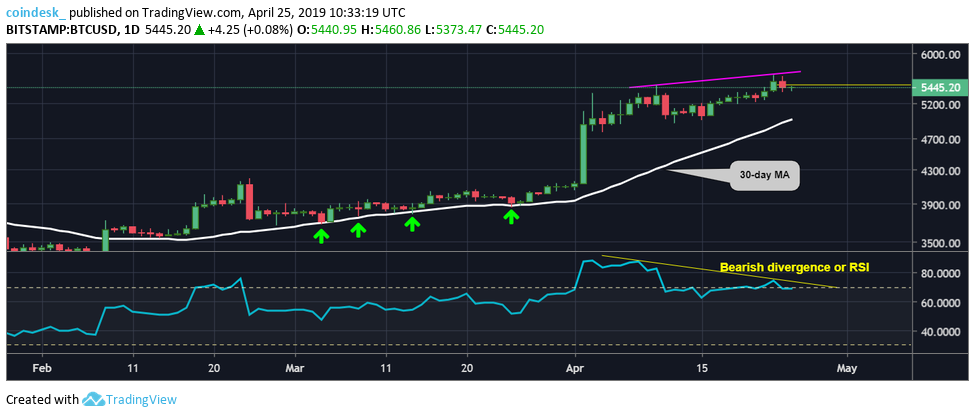View
- Bitcoin fell more than 1 percent yesterday, confirming a bearish divergence of the 14-day relative strength index, an early sign of bearish reversal.
- BTC risks falling to levels below $5,000 in the next few days.
- A strong bounce from the crucial 30-day moving average (MA), currently at $4,969, would revive the short-term bullish outlook.
- The long-run outlook will remain bullish as long as the price is holding above the former resistance-turned-support of $4,236 (Dec. 24 high).
Bitcoin (BTC) may revisit sub-$5,000 levels in the short-term, as a widely followed technical indicator is flashing a historically bearish pattern.
With the recent rally to five-month highs above $5,600, the 50-day moving average (MA) crossed the 200-day MA from below in what’s termed a “golden crossover” – a confirmation of long-term bull market.
However, short-term technical indicators, especially a bearish divergence on the relative strength index (RSI), are suggesting a drop in prices before the rally picks up pace again.
The bearish RSI pattern is widely considered an early sign of trend change and has yielded notable price pullbacks in the past.
The leading cryptocurrency by market capitalization is currently trading at $5,430 on Bitstamp – down 3.5 percent from the high of $5,627 hit earlier this week.
Daily chart
Bitcoin first jumped above $5,000 on April 1 and further climbed to highs above $5,400, lifting the 14-day RSI to 88.00 – the highest level since December 2017.
With the indicator signaling extreme overbought conditions, bitcoin’s price retreated to $4,912 on April 12 before jumping to a five-month high of $5,627 earlier this week.
Essentially, BTC created a bullish higher low at $4,912 and a higher high of $5,627. However, as bitcoin set the new higher high, the RSI instead formed a bearish divergence – a pattern confirmed with the near 2 percent price drop seen in the last 24 hours.
Historical RSI divergence
As can be seen above, BTC confirmed a bearish divergence of the RSI with a 2 percent drop to $9,623 on May 6, 2018, and fell 38 percent to lows below $5,800 by the end of June.
Before that, the 14-day RSI diverged in favor of the bears with bitcoin’s 6.5 percent price drop to $17,700 on Dec. 19, 2017. That was followed by a quick 36 percent sell-off to $11,200 by Dec. 22.
There are earlier notable examples, too (not shown). BTC fell 6.5 percent to $4,600 on Sept. 2, 2017. With the sharp slide, the RSI diverged in favor of the bears and prices tumbled to $2,972 on Sept. 15. Again that was a 36 percent price drop.
Another bearish divergence of the RSI on June 12, 2017, was also followed by a quick 20 percent price slide that ended at lows near $2,120 a few days later.
If history is any guide, the latest bearish divergence of the RSI could send prices down to $4,912 (April 12 low).
Daily chart
The 30-day moving average (MA), which served as strong support in March, is currently located at $4,969. Importantly, the average is still trending north, indicating a bullish setup.
A strong defense of that average would revive the short-term bullish outlook and could yield a rally to fresh multi-month high above the recent high of $5,627.
A violation there, however, could invite stronger selling pressure, leading to a drop to the 200-day MA at $4,466.
The longer-term outlook will remain bullish as long as prices are holding above $4,236 – the bearish lower high created on Dec. 24 and violated on April 2.
Disclosure: The author holds no cryptocurrency assets at the time of writing.
Bitcoin image via Shutterstock; charts by Trading View






